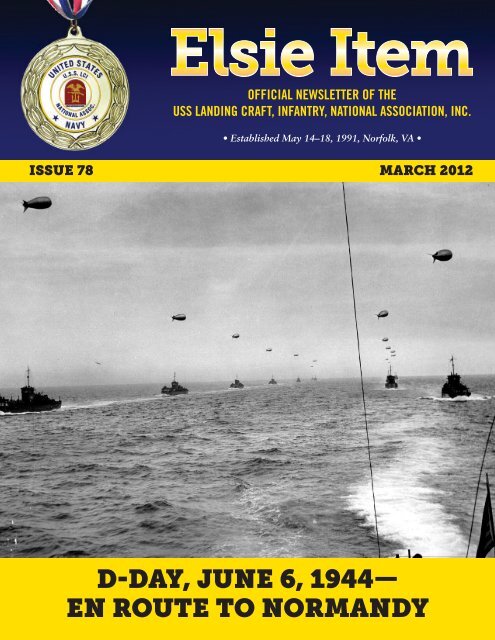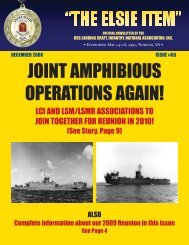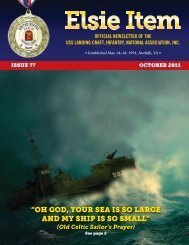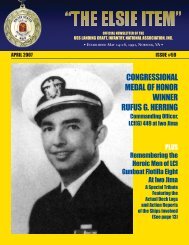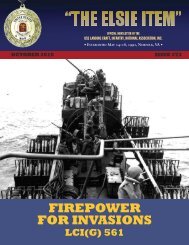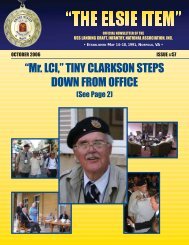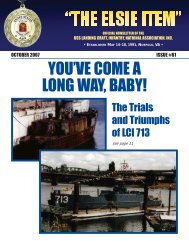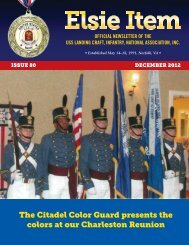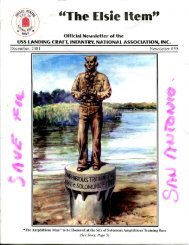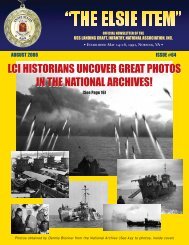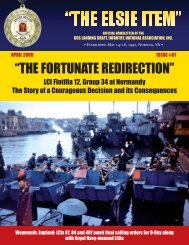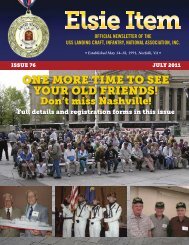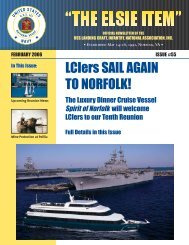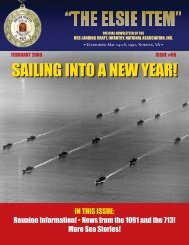elsie item issue 78 - USS Landing Craft Infantry National Association
elsie item issue 78 - USS Landing Craft Infantry National Association
elsie item issue 78 - USS Landing Craft Infantry National Association
- No tags were found...
Create successful ePaper yourself
Turn your PDF publications into a flip-book with our unique Google optimized e-Paper software.
OFFICIAL NEWSLETTER OF THE<strong>USS</strong> LANDING CRAFT, INFANTRY, NATIONAL ASSOCIATION, INC.• Established May 14–18, 1991, Norfolk, VA •ISSue <strong>78</strong> marCH 2012D-Day, June 6, 1944—en route to normanDy
“tHe eLSIe Item” numBer <strong>78</strong>, march 2012Official publication of the <strong>USS</strong> LCI <strong>National</strong> <strong>Association</strong>, a non-profit veteran’s organization. Membership in the <strong>USS</strong> LCI<strong>National</strong> <strong>Association</strong> is open to any U. S. Navy or U.S. Coast Guard veteran who served aboard a <strong>Landing</strong> <strong>Craft</strong> <strong>Infantry</strong>, toanyone related to an LCI veteran, or to anyone just interested in the history of LCIs. Published quarterly by the <strong>USS</strong> LCI <strong>National</strong><strong>Association</strong>. John P. Cummer, Editor. Any material for possible publication should be sent to the Editor, preferably by email(cummerj@bellsouth.net) or by regular mail to 302 Pinewood Cottage Lane, Blythewood, SC, 29016.on our Cover:A picture sure to bring back memories to LCIers who participated in D-Day at Normandy. Aconvoy of LCIs with those barrage balloons that were supposed to deter low-flying aircraft.Looking for an LCI Pin?Gordon Smith of the Amphibious Forces Memorial Museum wants you to know that the grey cloisonné LCI Pin isonce more available. They’ve been out for some time but have now received a new supply. You may obtain one bycalling either Rick Holmes at 509-427-5402 or Gordon Smith at 360-256-5901. You may also order one by mailfrom Gordon addressing him at:Amphibious Forces Memorial MuseumPO Box 17220Portland, OR. 97217Cost is $14.00 postpaid—and your purchase helps to fund the restoration of LCI 713!ooPS—Correction!Hey, we’re improving! Only one correction this time!In last <strong>issue</strong>’s list of donors we wrongly identified James T. Robert’s LCI as the 373. Jim wants you all to know thathis ship number was 438! Our apologies, Jim—we know how important the ship number is to an LCIer.2 | ELSIE ITEM | March 2012
a Word from thePresident/editorThanks for your thanks!Patricia and I were on our way to vote in our recent primary here in South Carolina (thank goodness, that’s over!) when shesuggested, jokingly, that I should take a cane and wear my WWII Veteran cap to make sure that we could get a good parking spaceand special attention. I did wear the cap just to see what would happen and, somewhat to my embarrassment, I got lots of smilesand thanks. Even the clerk who checked my registration smiled and said, “Thank you for your service to our country!”That sort of thing happens quite frequently, doesn’t it? And if you’re like me you are grateful and just a bit embarrassed at theattention. You feel like you ought to thank them for thanking you!So I want to take this opportunity to express our gratitude to our sons, daughters, grandkids and others who are joining us in the LCI<strong>National</strong> <strong>Association</strong> as Associate Members. We are grateful to them for coming alongside and offering their support. To all of themI’d like to say, in behalf of all of us old geezers, “Thank you for thanking us!”Any future our <strong>Association</strong> has depends on all of those Associate Members carrying on as we pass the flag to them. The shift isalready occurring—look again at the list of Associates who have taken their places as leaders: Vice President, John France;Secretary, Steve Dudrow; Chaplain, Mike Gatton, Pacific Historian Dennis Blocker and Directors, Joe Flynn, Diane Cronin, RobertWright.So, thanks, Associates! Thank you for thanking us!Charleston in September!The main reason why we go to our reunions is to see our old friends again and we hope that many of you are planning now to be withus September 9–14 in Charleston, but did you know that Charleston has been recognized as one of the best vacation destinations inthe nation? If you’ve been to Charleston, you’ll know why. The reasons are many: great history; sites such as Fort Sumter where theCivil War began, beautiful well-preserved architecture, wonderful Southern hospitality, some of the best food you will ever eat—thelist goes on and on.So, you won’t want to miss this one. In this <strong>issue</strong> you’ll find all the information on our reunion and the registration forms.—John CummerMarch 2012 | ELSIE ITEM | 3
egister now for theCharleston reunion,September 9–14!4 | ELSIE ITEM | March 2012
March 2012 | ELSIE ITEM | 5
6 | ELSIE ITEM | March 2012
March 2012 | ELSIE ITEM | 7
What do youknow aboutCharleston?If you’ve never visited Charleston, you’re in for a treat!Recently named as the top vacation destination in the United States, it’s a wonderful combination of history, beauty and charm.Here’s a bit more about this beautiful city:Charleston is the second largest city in South Carolina. It was made the county seat of Charleston County in 1901 whenCharleston County was founded. The city’s original name was Charles Towne in 1670, and it moved to its present location (OysterPoint) from a location on the west bank of the Ashley River (Albemarle Point) in 1680. It adopted its present name in 1<strong>78</strong>3. In 1690,Charleston was the fifth largest city in North America, and remained among the ten largest cities in the United States through the1840 census.Charleston is known as “The Holy City” due to the prominence of churches on the low-rise cityscape, particularly the numeroussteeples which dot the city’s skyline.The population was counted by the U.S. Census in 2010 at 120,083, making it the second most populous city in South Carolina,closely behind the state capital Columbia. Current trends put Charleston as the fastest-growing municipality in South Carolina.Charleston is located just south of the mid-point of South Carolina’s coastline, at the confluence of the Ashley and Cooper rivers,which flow together into the Atlantic Ocean. Charleston Harbor lies between downtown Charleston and the Atlantic Ocean.Charleston’s name is derived from Charles Towne, named after King Charles II of England.America’s most-published etiquette expert, Marjabelle Young Stewart, recognizedCharleston 1995 as the “best-mannered” city in the U.S, a claim lent credibilityby the fact that it has the first established Livability Court in thecountry. In 2011, Travel and Leisure Magazine named Charleston“America’s Sexiest City”, as well as “America’s Most Friendly.”Subsequently, Southern Living Magazine namedCharleston “the most polite andhospitable city in America.”8 | ELSIE ITEM | March 2012
March 2012 | ELSIE ITEM | 9
LCI 1091 Still recruiting For the navy!Eight Navy Recruits raise their right hand as Capt. Mark Neeson, USN Ret., administers the oath aboard the <strong>USS</strong> LCI 1091Eight Navy recruits were sworn in aboard the <strong>USS</strong> LCI 1091 in Eureka, CA December 18th by Capt. Mark Neeson, USN (Ret.) Navyrecruits usually take their oath in large groups, far away from family and friends, but the 1091, flagship of the <strong>USS</strong> LCI <strong>National</strong><strong>Association</strong>, is becoming a popular site for northern California enlistees. Smaller groups, close to home and friends and relativescan take part in the occasion. Everybody loves it.Capt. Neeson is one of three Board members of the Humboldt Bay Naval Air/Sea Museum, which is restoring the 1091.Bosun’s Mate Herb Wall, a WW II Sailor who still fits in his 1945 tailor made blueswas on hand to pipe the recruits and guests aboard. Herb was aboard the CVE <strong>USS</strong>Bismarck Sea when she was sunk off Iwo Jim. In rough seas, in the dark of night,Herb was spotted by a searchlight from a destroyer and was the last man from theBismarck Sea to be rescued.The occasion was a great sendoff for these new members of the U.S. Navy. Itbrought out veterans from all wars since WW II and all branches of service.10 | ELSIE ITEM | March 2012
a Son remembersHis Father’s LCI DutyBy Dr. Jim CookDr. Jim Cook, now retired and living in Panama City, Florida, is the son of Joseph B. Anderson who served aboard <strong>USS</strong> LCI(L) 39.Shortly before his father’s death in 2010 at the age of 97, Dr. Cook interviewed his father at length concerning his life. He shareswith us that portion of his father’s life dealing with his experiences aboard LCI 39.Joseph Bertrand Anderson was born to Swedish émigré parents in Fort Dodge, Iowa. He achieved his degree in physics from IowaState Teachers College and later a Master of Science in Economic Zoology from Iowa State. He taught school in Iowa and marriedLouise Brodine, of Sioux City, Iowa who also had Swedish parents.After the disaster at Pearl Harbor in December, 1941, Joe joined the Navy where he was commissioned as an Ensign and went toAmphibious Officer Indoctrination School in Chicago. While there it was notable that one of his roommates in the hotel was John F.Kennedy, but after Commander Buckley gave a talk at the school about the thrill of Patrol Torpedo Boats, the next morning JohnKennedy departed the Amphibious Training for his legendary assignment ultimately leading to PT 109.After Chicago it was Purdue University for training in diesel engineering for two and a half months, then transfer to Norfolk, Virginia,for further Amphibious training on Chesapeake Bay. He was assigned as Engineering Officer to LCI 39 which was commissioned at thePhiladelphia Navy Yard.After a shakedown cruise on Chesapeake Bay, they remained in Norfolk for maneuvers and practice landings for two months.Finally the tiny LCI 39 joined a convoy in March, 1943, bound for the Mediterranean where the invasion of North Africa had just beencompleted and the Allies were working on General Rommel and his Afrika Korps with General Patton and Field MarshallMontgomery heading up the effort.At this time in the war the Germans were at their peak of sinking Allied ships with submarine wolf pack warfare, but Joe’s tripacross the Atlantic in LCI 39 was uneventful. They took solace in the fact that the LCI had such a shallow draft that they were reallynot vulnerable to the torpedoes as they would just pass under the ship. However, submarines would come to the surface and usetheir gun on shipping. During the trip across the Atlantic one of the LCIs got separated from the convoy and the scattering of theconvoy each night in blackout conditions was the norm, but this errant LCI made it to port at about the same time that the rest ofthe convoy arrived. Their destination was a small port near Oran in North Africa. They were moved several times and wound up atLake Bizerte.The big event was the invasion of Sicily at Gela Beach where Joe finally joined the war with bombs falling in the distance whileBritish vessels with their 15 inch naval rifles pounded the shore in support of the troops as LCI 39 dropped its stern anchor andbeached on Sicily. They made numerous trips back and forth across the Mediterranean to Bizerte and then again to Sicily, unloadingtroops and supplies on the beach.This duty continued while General Patton and Marshall Montgomery were having their race across respective sides of Sicily toPalermo, but the Germans ultimately escaped, crossing the five miles to Italy at the Straits of Messina to fight another day while heItalians frantically looked for a way to get out of the war.Negotiations were started with the Italians who waffled and delayed, so an invasion of Italy was conducted into Salerno which wasdown past the Amalfi Coast south of Naples. Once again, LCI 39 made numerous trips, about 24, back and forth between Sicily andSalerno, carrying, this time, British troops and supplies.After Salerno and the initial successes, the Germans took over all of Italy and started fighting fiercely in the boot of Italy. Joe’sship was transferred to Pozzuoli, near Naples, where he finally got to go ashore. We have a picture of him standing by a Willys MBJeep on that occasion.The LCI 39 was on call for several months, then helped with the invasion of Anzio-Nettuno south of Rome. This action wassupposed to have shortened the war in Italy, but actually bogged down into a stalemate. Anzio was a hellish beach in range of theGerman long guns in the hills as well as being the target of many German air raids, including a new radio-guided glide bomb.March 2012 | ELSIE ITEM | 11
LCI 39 was in the first wave to hit the beaches at Anzio and the LCI next to them received a direct hit by a bomb while on thebeach. That LCI was destroyed and the 319 was damaged with so many fragments that its fuel oil was contaminated by sea water.They had to be towed back to Naples for dry dock repair for the ensuing two months while the crew waited on the ship.After repairs, LCI 39 took part in the invasion of Elba, a British and French operation. This time the 30 was loaded withSenegalese troops who had no idea what was going on and were duly deposited at Elba which was supposed to be a surprise so thatthere was not a naval gunfire or air raids prior to the landing. Joe and his ship did their job again, but the entire operation causedmore casualties among those soldiers than were expected.In July, 1944, Joe was posted to the Charleston Navy Yard in South Carolina where his wife, Louise, met him and they shared asmall apartment, but had no car. His office tracked LCI repairs and supplies. He remembers that they sent a lot of stuff to theRussians. The biggest event during that time was the surrender of Germany in May, 1945, so the entire attention of the war effortwas then turned to the Japanese. In July, 1945, Joe received orders to San Francisco for further transportation to the Philippines, soLou returned to her parents’ home in Sioux City, Iowa.Joe’s new assignment carried him to Leyte Gulf in the Philippine Islands where he was assigned to LCI 606 where he worked tocoordinate an LCI Group.In his absence his first daughter, Kay, was born in Sioux City, Iowa. Then in August came the news of the atomic bombs droppedon Hiroshima and Nagasaki with the surrender of the Japanese shortly thereafter. LCI 606 was directed to go to Tokyo, but off ofOkinawa, while motoring alone, they were caught in a typhoon, the bane of Pacific sailors. The Captain saved the small ship bydirecting that it be backed into the wind so that the bow of the ship would weather vane. In this manner they rode out the typhoonwhich sank many ships, but not this resourceful LCI.In Tokyo Joe was transferred to a destroyer as a passenger and departed for San Francisco. Upon arrival there he traveled by trainto Great Lakes Naval Training Station where he was mustered out of the Navy.Joe Anderson was a true American patriot who did his job without question under difficult circumstances, a common trait of the“Greatest Generation,” and I am very proud to have known him.Here’s one for all you old Motor Macs—the Engine Room Control Station!12 | ELSIE ITEM | March 2012
LCI (L) 989 and the “yangtze Incident”By Horace Craig, Radioman, LCI 989Reprinted from Sea Classics MagazinePerhaps one of the most unusual stories of post-WWII LCI experiences was that of the 989. While stationed in Shanghai in Ju1y of1949, she was called upon to assist in evacuating wounded from, HMS Amethyst, a British frigate that had come under heavy firefrom Communist shore batteries while on a routine Yangtze River patrolThe LCI (L) 989, commissioned late in the war on 22 May,1944, was pressed into service for a variety of post-warduties. She, for a time, was station ship in Hong Kong,serving the U. S. ConsulateShe later became the US Navy’s “smallest aircraftcarrier.” A catapult was installed on her bow and fourairmen and four radio-controlled drones were put aboard.The mission was to provide aerial targets for antiaircraftcrews on fighting ships. This service ended when it wasthe flagship’s turn to shoot. All four dronesmalfunctioned and splashed into the sea at the end of thecatapult.Some of the 989’s crew figured a displeased superiormay have had a hand in the ship’s next assignment. Itbecame a temporary “outhouse”—providing “sanitaryfacilities” for sailors aboard a destroyer undergoing repairsin a Tsingtao shipyard. Since it was Christmas time, the989 crew hand-lettered a sign for the gangway: “Merry Christmas! Come aboard and flush your cares away!”LCI (L) 989 moored to a buoy in Hong Kong during herpost WWII tour of duty in the Far EastThis was 1949 and the Communists were on the move again. The thin-skinned LCI was ordered up an ice-choked river to Tientsinto evacuate American nationals. Chunks of ice in the river continually slammed into the thin hull. The 989’s main heater went out.The crew tried lighting an auxiliary heater in the forward compartment, but the smoke was worse than the cold. Some of the crewfinally—and successfully—cut tin cans in half, laced wire across, and plugged them into the ship’s electrical system. The juryrigged“electric heaters” helped, but some of the crew said they didn’t warm up until they left that place.Next came the “Yangtze Incident.” HMS Amethyst, a British destroyer, was trapped upriver and was being pounded by communistartillery. LCI 989 and another small amphibious craft which happened to be in Shanghai were pressed into service to transport thewounded down the Whangpoo River to the Woosung anchorage at the mouth of the Yangtze. Wire basket litters filled with woundedfilled the mess hall and passageways of the 989. She came alongside the hospital ship Repose to off load the wounded. Many ofthe British sailors, though seriously wounded, joked with crewmen of the 989.Then came the evacuation of American nationals from Shanghai as the civil war threatened that city. The 989 was lit bycommunist flares as it made its final run down the Whangpoo and out the mouth of the Yangtze. Luckily, the Yangtze is very wide atthis point and the 989 was bothered no more.On arrival in Hong Kong the task force commander sent over a “reward,” a big container of ice cream which the 989 crew quicklydevoured.The 989 needed some bottom work and was ordered to a dry dock built to accommodate battleships. The tiny LCI was dwarfed inthe massive structure. The crew got a laugh as one of the workers on the floor of the dock called for a huge crane to lower its hook.He ceremoniously attached a fish which had been stranded in the now waterless dry dock. He signaled “Haul away!”Dockyard workers rigged a gangway for the 989’s crew to come and go. One end was anchored on the 090’s bridge, the highestpossible point aboard ship, and it still was a steep climb to get to dockside.The 989 soon was off to Seattle to prepare for decommissioning. At the end it was towed to Astoria, Oregon and moored with theReserve Fleet in the Columbia River.March 2012 | ELSIE ITEM | 13
naVy DaySrecollections of robert m. morrisRobert Morris, now a resident of Santa Barbara, CA, remembers well and writes well of his experience aboard LCIs.After graduating from Midshipman’s school in Chicago in 1943, he was given orders for duty aboard LCI (L) 1026, then underconstruction in Portland, Oregon. He served aboard the 1026 until she had finished shakedown cruise and was in San Diegoawaiting orders to sail for duty in the Pacific theater of operations.In December, 1944, Robert was reassigned to duty as Gunnery Officer aboard LCI (L) 631. Converted to an LCI (G), the 631 served inthe Iwo Jima operations in February, 1945. She underwent a further conversion to an LCI (M). In April, 1945 she participated in theassault and occupation of Okinawa from March until April, 1945. Following World War II she performed occupation duty in the FarEast from 23 October to 11 December 1945 and China service from 11 December 1945 to 12 June 1946.We share with you here excerpts from Robert M. Morris’s account of his World War II experiences in the Navy.A Grounding at OkinawaThe weather was bright and sunny as we approached the island. As dawn broke we began the first of many mortar runs off theinvasion beach, a bit north of the main town of Naha. There were an awesome number of ships massed to support the invasion. AsI recall, we ceased our firing runs about dark and steamed slowly without anchoring. By dark that day, what had been a beautifulgreen island was a barren waste with practically all leaves stripped off the trees in sight of the landing area.On the day of the invasion we were given orders to fire up our smoke generators to help blanket the anchorage with an incrediblydense, oily fog. The smoke generators used a special oil and steam to generate the smoke screen. On our ship it was so thick onecouldn’t see more than a yard away and we had to feel our way around while on deck. We and other ships made smoke all night andcreated a blanket over the anchorage perhaps 200 feet thick. Since we were underway, we had to depend on our radar to see wherethe other ships were, though a light breeze from time to time formed patches of clearer air.During the first night, I had the underway watch and was much concerned about a patch of coral reefs in our vicinity that wereshown on our chart. We were followed by five or so other LCIs as we were the group Flagship. We were moving at only three or fourknots when the Captain, LT Phillip Hamilton, came up to the conning tower to relieve me for a coffee break. I explained to him where14 | ELSIE ITEM | March 2012
I thought we were and my concerns about the reef. He brushedme off with some remark that suggested he could handle theproblem and relieved me at the conn.I went below, got myself a cup of coffee, sat down in thewardroom and started to chat with one of the officers alreadythere with his cup of coffee when I felt and heard a crunchingsound which told me we had run aground on something solid. Iwent topside, grabbed a 16-foot boat hook, and started aroundthe perimeter of the ship discovering that all but about a thirdof the after part of the ship was resting on a reef. I reportedthis to Captain Hamilton who was on the bridge, fuming aboutthe situation. He did not enjoy my news. He was in a very surlymood and, having warned him earlier about the danger, Ithought it best to get out of his way.Our immediate problem was to warn the ships following us.This was not a simple matter because we couldn’t use our radioor our signal searchlight, but had to rely on a relatively untrieddevice using infra-red light. We started at once, but it tookforever to send even a short message and by the time wesucceeded, at least two other ships joined us on the reef. Allthree ships had to spend most of the night grounded—sittingducks in the event of any bombing or kamikaze activity. Neardaylight the tide floated us clear and we resumed our mortarruns. I never found out what, if anything, or Captain heard fromthe Senior Officer present about the whole thing but, being alanding ship, we sustained no damage apart from losing somepaint on the hull.Sardines and C-RationsOn one occasion we were not far from an ammunition shipwhich was targeted by a Japanese plane. Fortunately wespotted it early and had our guns trained on it as it approached.Before the other ships had a chance to fire, we brought it down.It crashed into the sea not very far from the ammunition shipwhose crew was more than a little grateful for our gunner’squick action.Air raids were a constant thing during the first few weeks atOkinawa and we spent so much time at general quarterseveryone was short on sleep and in need of a peacefulmeal. During this stressful period, one of the sillylittle things occurred that I recall clearly. Thehead of our 40mm gun crew was a softspokenfriendly Gunner’s Mate namedCharlie Lapinski, from Hamtramck, aworking-class suburb of Detroit.Charlie got hungry while on one of theselong general quarters alerts and askedone of the assistant gunners to go get him something to eat.The assistant gunner had just finished a can of sardines and acouple packages of C-ration biscuits. These biscuits lookedexactly like graham crackers but tasted more like dog biscuits.Presumably they were very nutritious.So this assistant gunner rubbed some of the grease off the guntrunion onto the biscuits, poured the remaining oil from thesardines over the cracker and gave several to Charlie whopronounced them “good!” I found out about this after the factand was worried that the gun grease would make Charlie sick.It didn’t, and I decided not to tell Charlie. Believe it or not, hesurvived!Cutting Loose!On another occasion we were riding at anchor off Naha withsome other LCIs nearby. We received a radio order to pick upour anchors and move to a different spot because the SeniorOfficer Present (SOPA) wanted our spaces for some othervessels. The ship next to us tried to obey, but had greatdifficulty raising its anchor. The stern anchor winch wasstraining and the clutch was smoking by the time the anchorcame into sight. It had hooked a submarine telegraph cable!The skipper of the ship tried to explain to the SOPA why theywere having problems, but were cut off with curt orders to getmoving. Finally, in desperation, they used the ship’s fire ax tochop the five inch cable in half. With all the strain on it, thiscaused the stern to pop upwards and nearly knock down thesailors there on their knees.I always wondered whose telegraph cable that was and whateffect it had on the course of the Okinawa battle.How Not to Flavor Your FoodAfter we were released from Okinawa duty we were ordered backto Pearl Harbor for a complete refitting in preparation for thelandings on the Japanese home islands, something very few ofus looked forward to.A day or so out of Eniwetok, one of the black gang wastransferring fuel and water to trim ship. Inadvertently hehooked the hoses up incorrectly and transferred about300 gallons of diesel oil into our one remaining freshwater tank before he discovered his error. We didwhat we could to skim the oil off the water beforeusing it to cook with or to make coffee, but theresults were less than wonderful. The group doctor,Andy Detesco, assured us that a little diesel oil in ourfood and coffee was not a significant health <strong>issue</strong>, but after aMarch 2012 | ELSIE ITEM | 15
cup or two of that mix most all of us switched to canned fruitjuice until we used up all we had aboard or could borrow fromother ships in our group. Before we got to Pearl Harboreverything and everybody seemed to smell like diesel. Salt waterworked for some of our cooking, but, as every LCIer knows, saltwater isn’t very good for showers, washing one’ face, shaving—or drinking.Good Duty at Pearl HarborWe were anchored in West Loch of Pearl Harbor when we got thenews of the devastating new type of bomb that had pretty wellobliterated Hiroshima and Nagasaki, followed soon after by theJapanese capitulation and V - J Day and the end of the war.That night several of us went in to Honolulu to celebrate.Civilians in town were outnumbered; it seemed, ten to one byArmy, Navy and Marine personnel. Every civilian woman insight got endless hugs from the elated servicemen. Everybody Isaw was overjoyed by the news and back at Pearl Harbor thatevening, most ships fired off their Very Pistols, a signalingdevice that shot off colored fireworks like a Roman candle. TheFleet Commander tried in vain to put this aspect of thecelebration to a stop because of concern that someone mightget injured or that a fire might be started. As far as I recall, wehad neither serious injuries nor fires.Because Pearl Harbor was so crowded and we had no real dutythere, we were sent to the beautiful island of Kauai. Kauai wasa beautiful rural island in those days with no tourist hotels andbeautiful, nearly deserted beaches. Farming and fishingseemed to be the chief occupations. Several of us often hitchhikedaround the island and by the time we were sent back toPearl Harbor we had pretty well traveled over all the roads.On one of these hitch-hiking tours, we were picked up by theCircuit Judge, Philip Rice, who later became Chief Justice of theHawaii Supreme Court. He insisted that we come to his houseon the beach at Koloa and have breakfast with him. The factthat we had had an earlier Navy breakfast was irrelevant!He had a beautiful house right on the beach and showed uswonderful Hawaiian hospitality. We returned there severaltimes to enjoy a meal and a swim at his beach.After the cessation of hostilities, the 631 was sent to China foroccupation duty. Our final anecdote from Robert’s memoirsinvolved a situation in which it is doubtful that any other LCIever experienced.Shanghai to go north to a place called Shalutien Shoal and try topull a freighter free from the shoal. When we got there we found theSS Marine Leopard, a brand-new cargo ship from the United Stateswith a miscellaneous cargo. The freighter was a good deal biggerthan we were; it was17, 000 tons and we were about 350 tons.We tied up alongside and succeeded only in parting most of ourbig hawsers without budging the huge ship. We then tried todrag their huge anchor off a way to see if their anchor winchcould do the job. Again, we just didn’t have the power to evendrag a four or five ton anchor.After reporting this to Shanghai, we were ordered to stand byand to provide security as the cargo was unloaded into whatwas called a Coolie Hulk. The Coolie Hulk was duly broughtalongside by a small tow boat and the unloading began.Coolies, in cold weather, wore long padded parka-like coatswhich made a convenient place to hide things they had pilfered.Our job was to frisk them after the unloading and we found anumber of surprising <strong>item</strong>s. The most surprising were rubberbaby pants! One coolie had stretched two or three pairs overhis legs under his padded coat, and I have no idea at all whathe thought he might do with them.Shanghai was most concerned about the whiskey that wasaboard. There were a hundred or more wooden cases ofbourbon aboard and we received several messages remindingus that this was very important cargo. After all the unloadingand frisking was done, the Captain of the Marine Leopard gaveeach one of our ship’s officers a case of bourbon as thanks. Iwas not a whiskey drinker, so had a chat with Hamilton, one ofour Chief Petty Officers, who reckoned he could get a very goodprice for my case if I were willing to sell. I was and he did and Iinstructed him to take a proper commission, which I think healso did. In any case, I got about $100 in cash.After our futile attempt to re-float the Marine Leopard we weremuch more successful in looking after the whiskey. We wererelieved and sent back to Take. A large tug came fromsomewhere and dragged the ship to safety. The Captain of thebig ship told us that the reason he had run aground was that alight was shown on his chart of the shoal despite the fact thatit was not serviced during the war and the Chinese had not yetgot around to putting it back into service.Robert and the crew of the 631 turned their ship over to theChinese after training the Chinese crew, a rather difficult job.In March, we got an emergency message from headquarters in16 | ELSIE ITEM | March 2012
The 631 Changes <strong>National</strong>ityRobert Morris’ ship, the Ex <strong>USS</strong> LCI (G) 631 underway inthe Republic of China service as ROCS Lien Hua (L-285),circa 1963. Location unknownIn April, we were ordered to go to the big port of Tsingtao totrain Chinese crews to operate LCIs as the Navy was preparingto turn over many of our group to the Chinese <strong>National</strong>ists.This proved to be quite an experience partly because of theneed to pass instructions quickly through an interpreter, butalso because of what might be called cultural customs. Isuspect, because of the Chinese sailors just weren’t verybright, having been dragooned into their Navy by some meansor other. It was further complicated by the fact that theChinese officers were nearly all of higher rank than we, theirinstructors, were. It was very difficult to find a diplomaticmeans of pointing out errors on their part without at the sametime causing them to lose face in front of their junior officers orcrew. Our Captain would get so frustrated trying to deal withhis Chinese counterpart that he would stomp off the bridgeand tell the first American officer he encountered to go up onthe bridge and take over the instruction. Sometimes when theship was underway the Chinese Captain was looking at ourCaptain rather than where the ship was headed. Several timesI had to tell our helmsman to take over quickly to avoid acollision with another ship. Similar problems took placeamong the enlisted men. In one case a Chinese engine roomsailor just decided to pull all the switches on the mainelectrical panel, effectively stopping the rudder control, thegalley stove, the bilge pumps, etc. Things were pretty chaoticat first but gradually improved. It was becoming increasinglyevident that the <strong>National</strong>ists under Chiang Kai Shek werelosing the country and that Mao and his folks were taking over.We wondered if the crews we had trained would be able to getthe ships to Taiwan (Formosa) in time. I guess most did.Homeward BoundBy June, 1946, we were getting increasingly short-handed asmembers of the crew and the officers got enough points basedon length of service, age, sea time and marital status to bedischarged. I was moved into the slot as Executive Officer. Welost all the enlisted men who could type leaving me as the onlyperson aboard who could use a typewriter. As a result theCaptain did not want me to go and tried to entice me to stay onafter I had enough points. I had had enough of training theChinese Navy so refused all his enticements.Naturally I was interested in getting home as quickly aspossible so kept my eye open for chances other than waiting fora transport. One day I happened to meet the skipper of a smallNavy oiler that was due to sail home via Saigon, Singapore,India, the Suez Canal and England. He desperately neededanother deck officer so I asked him if he would accept me if Icould arrange it with the Senior Officer in Tsingtao. He said hewould be delighted and even wrote me a note to be passed onto the Senior Officer. I got an appointment with the SeniorOfficer and told him what I wanted to do. Unfortunately he wasone of those people who never want to accept any suggestionsfrom juniors, no matter how sensible. He told me he wasn’tabout to have his junior officers arranging their homewardtransport and to return to LCI (L) 632 and wait for orders. Ihadn’t handled this very astutely so missed out on what wouldcertainly have been an interesting trip.In June I went aboard the <strong>USS</strong> General Butler, a huge trooptransport carrying several thousand sailors and naval officers.We sailed non-stop straight across the Pacific from Shanghaito San Francisco. Many of us aboard received quite a bit ofback pay in cash as we boarded this ship. During the course ofthe voyage there were dozens of high-stakes poker gamesplayed. I sat and watched some of these games and quicklyrealized that my poker skills would quickly lead to poverty if Igot involved even once, so I abstained.Return to Civilian LifeIn San Francisco I was returned to inactive duty and providedwith a train ticket home. Naval Reserve officers had to remainon the inactive roles for ten years after the war, subject torecall. I did not participate in any Reserve activities until, in1949, I joined a special oceanographic research unit that theNavy had in San Diego. The unit was not scientifically orientedso I decided, after a few meetings, to just wait for my formaldischarge which came about in 1955 or 1956.In retrospect, my days in the Navy were educational, maturingand often interesting. I treasure my experiences in the Navyand especially appreciate the life-long friendships made andthe opportunity to relive some of these experiences with otherswho shared them.March 2012 | ELSIE ITEM | 17
Southern California LCI Sailors HoldLast Pearl Harbor Day Luncheon inoceansideBy Joe FlynnCalifornia DirectorThe 15th Annual LCI Pearl Harbor Day luncheon was heldSaturday, Dec. 3, at Hunters Steakhouse in Oceanside, CAwith 25 LCI Sailors and their guests enjoying good food, goodcompany, and a good round of sea stories.These luncheons were started in 1996 by Jim McCarthy,late California director. That was a year after Jim convincedCapt. Ralph Davis and a crew of original LCI Vets to sail the<strong>USS</strong> (L)1091 from Eureka, CA 850 miles south into San DiegoBay and into the hearts of LCI sailors for the largest LCI<strong>National</strong> Reunion before or since. Nine hundred and fiftywere registered for that gathering and the widespreadpublicity gave the <strong>Association</strong> a real boost.During the 1091’s five days in San Diego, 1,568 peopletoured the ship, many of them LCI Sailors who had not yetheard about the LCI <strong>Association</strong>. Soon after, the 1091 wasnamed the Flagship of the <strong>USS</strong> LCI <strong>National</strong> <strong>Association</strong>, atitle she still holds today. In the years that followed,McCarthy organized California LCI reunions in Eureka, CA,home port of the 1091. Each year Capt. Ralph and First MateBobbi Jo Davis opened their ship and their hearts to LCISailors from California, surrounding states and visitors fromacross the country. After many reunions, the Davis’ donatedthe 1091 to the Humboldt Bay Naval Sea/Air Museum whereit is now being restored, still hosting smaller reunions, andstill open to visitors year round.This year, due to the toll of time and the impediments totravel the Pearl Harbor Day luncheon in Oceanside this yearwas our last scheduled event there. We will still gather, insmaller groups, and random locations. Any place we can geta few LCI sailors together and get the sea stories rolling theparticipants and spectators are guaranteed to have a goodtime. Till we meet again,Fair Winds and Following Seas!Jack Walters, LCI (L) 668 reports on our 2011reunion in Nashville. Wife, Yvonne, looks onJimmie Prime LCI (G) 373 shares his experiences providing firesupport for UDT teams prior to Pacific island invasions.Daughter Patti Prime looks on. Owen Accorsi, who served aboardthe Flagship of the LCI Assn, the LCI (L) 1091, during the KoreanConflict, waits his turn on the microphone.18 | ELSIE ITEM | March 2012
LCI (L) 1 attacks Sicily all By Herself!From a letter to Paul Mascatelli <strong>USS</strong> LCI)L) 24 from Curtis Boutelier MoMM2/c <strong>USS</strong> LCI(L)-1, dated January 6, 2007, describing hisrecollections of what happened to LCI(L)-1 and her crew during the assault at Licata Sicily.<strong>USS</strong> LCI (L) 1 broached on the beach at Sicily“My beaching station was the stern steering engine room. Theescape hatch from the steering engine room was open andwhen the Jerries opened up on us, the tracers from the fourbarrel 20mm up on the high bank put out enough shells tohighlight the complete fantail. Ohe, M0MM2/c was ready to dropthe winch anchor when ordered. The 20mm’s opened up beforethe order came and he was badly wounded. As a result, ourstern anchor was not dropped and we broached.“Stark QM/2c was in the con. An armor piercing 20mm hithim in the shoulder. He died of blood loss and shock. Mace wason the wheel and a 20mm hit him in the chest. I can recall (Ihad the head phones on) the sound that he made as the roundhit him. It was armor piercing. It came through the front of thepilot house, killed Mace, exited the back part gouged a dent inthe deck and kept on going.“Pinky S2/c was on starboard ramp, an explosive 20mm gothim on the helmet. His brains were splattered on the steel closeto the ramp. Our Executive Officer, Mr. Palmer, in the conn, wasalso wounded.“Moore and Rice manned the bow 20mm. How they survivedthe concentrated flak is a miracle. While still not close to thebeach Moore fired back and killed the Jerries manning the 4barrel 20mm. Moore would fire, drop down and Rice would slamon another ammo drum on the 20mm.“After broaching we were pounded with mortar rounds. Thecaptain commanding the 3rd Division troops aboard wasriddled with shrapnel and died on the deck in front of the pilothouse. I remember so well his wallet contained photos of hiswife and small children. Still get teary eyed to think of it.“In the context of the great war, the landing at Licata beachplayed a small part, to the shipmates of mine that died there,we are forever to remember that they are forever young.”Looking back on those events I can almost come to theconclusion that we were deployed to draw fire before the rest ofthe LCIs hit the beach. The LCI’s were one behind the other,sailing along when the LCI-1 turned to starboard and proceededto conquer Sicily all by her lonesome.March 2012 | ELSIE ITEM | 19
A Thought fromChaplain Mike Gattona Hole in the BoatWith recent news stories on “How Not to Sail a Ship”—the tragic Costa Concordia accident and the cargovessel which took out a bridge here in Kentucky—I though it fitting to write to a bunch of “old salts” regardingthe problem of a hole in the boat.Picture an ocean liner with about seven different decks. At the top is the captain on the bridge, looking at thesplendid view. The next level is the lounge, where people are engaged in conversation and drinks. At the nextlevel people are eating excellent food from the buffets. And, then, there’s the sundeck, where people areswimming and tanning. Finally, there’s the cabin area. Way at the bottom there’s the theater, and aft the engineroom. Next to the engine room, just slightly above the mechanical room, is a little washroom. The little simplecrewman who is running the washroom is getting sick and tired of all the rich tourists on the cruise leaving amess and running off with the towels. Nobody pays attention to him or his complaints. He feels forgotten,isolated and abandoned. Those who come to use his room simply don’t listen to his rules.Finally, he decides that he’s not going to take it any longer, so he gets a hammer and nails and hammers thetowels to the wall. “Now, they won’t run off with my towels!” he says. The captain, who could care less, didn’tknow about it. The people at the bar or in the restaurant and the people around the pool really didn’t care.Nobody cared what the little guy in the washroom did with his towels. If he wanted to hammer them to the wall,he could just go ahead.The man who hammered the nails had never seen a blueprint of the ship and didn’t know that his washroomwas on the hull. When water started leaking into the washroom, he jammed a bar of soap into the hole, only tosee it dissolve. He stuck his fingers into the hole, but that didn’t solve the problem. In desperation and hysteria,he pulled his fingers out. By then, he was standing in ankle deep water. It would only be a matter of time beforethe captain and all the passengers were going to finally be concerned about some little guy in the washroom whohammered the towels to the wall of the ship.The point being this: a hole in a boat is a hole in a boat. All of us who live in this land and on this planet are onthe same ship. We can take an I-don’t-care attitude like the captain at the top towards the little man in thewashroom and not listen to his problems and complaints. We can take that kind of attitude towards other peoplein other states, other professions, other races, and other nationalities. But, you can be sure: a hole in the boat isa hole in the boat, and we are all on this boat together.Agape, MikeMarch 2012 | ELSIE ITEM | 21
my Grandfather:a Cigarette Salesman??Submitted by Mark MuningerRecently, upon the passing of my Grandfather, Ralph William “Bill”Blattner at the age of 95, these photos of himself and LCI(L) 944were located. This photo was taken for a potential cigaretteadvertisement, but I do not know what brand or exactly when thepicture was takenBefore the United States entered the war, he was a school teacher inwestern Kansas. When the Japanese attacked Pearl Harbor onDecember 7, 1941, he was furious and immediately signed up.Ironically, he passed away on December 7, 2011.The 944 was one of the LCIs to avoid the scrap heap at the war’s end.After being taken out of service as an LCI, she was re-commissionedAs <strong>USS</strong> Magpie, AMCU 19. In 1954 she was re-fitted as a minehunter, retaining the name Magpie, but re-designated MHC 29. Afterfinal de-commissioning she was sold to a Randolph Mattson andsubsequently sold to Tropicana Products in 1961. In yet anothername change, she became the Abaco Trader and was known to stillbe in service in 1981. Her final fate is unknown.22 | ELSIE ITEM | March 2012
yank Sailor Plays midwife toItalian mother on LCI.By Bill BrinkleyStars and Stripes Naval WriterGordon Smith found this article, written by LCI <strong>Association</strong> member Bill Brinkley when he was working as a writer for Stars andStripes. The story had special interest to Gordon since his LCI was operating in the same area as this LCI, whose number isunknown. Gordon and his crew landed at Anzio around January 21st in 1944 and were there until May 10th when the army broke outof the beachhead. He tells us that, during that time, it was common for the LCI's to haul replacement troops up to Anzio andrefugees back. This is the story of what happened on one of those trips with refugees.The event all American sailors to this area have been waiting for has happened—an Italian baby has been born on an AmericanMan O' War.It happened at 0430 hours the day after Easter as the ship, an LCI (landing craft infantry), was coming into a southern Italian portwith a load of refugees from Anzio.The baby, a boy, was delivered by 18-year old Anthony Saverese, pharmacist's mate second class, Brooklyn, who speaks Italian andcame to the ship from the States a bare three weeks ago.The parents named the new-born George Raymond Camilla, after the two crewmen who contributed most to a 30-dollar pot theship's company collected.It was the most trying 30 minutes in the life of the energetic Saverese.At 0415 hours a shipmate came running into the ship's tiny sick bay in No. 3 hold with the news that a woman in No. 1 hold was in abad way and maybe that way.The voyage from Anzio had been rough. Saverese had been up all night tending to ailing and seasick refugees, among them manybabies. He hurried up the ladder and down to No. 1 hold. He took one look and although he is unmarried and had never hadprevious experience in this sort of thing, he know instinctively there was not a second to lose.With her father, mother, husband and sympathizing country-men following behind, Signora Camilla was carried by the sailors up theladder from No. 1 hold and down into No. 3 hold, where what meager facilities the ship had for bringing babies into this world werelocated. The signora's four earlier children were taken in charge by some of the countrymen and kept behind.Signora Camilla was placed on a bunk. Saverese sent word to the galley for hot water. He jerked out the Navy medical book, beganrunning through the index looking for "birth" or "childbirth."He couldn't find a word on the subject. Hot water arrived from the galley. He laid the book down and decided to rely on commonsense. Using sterilized sick-bay instruments and aided only by an aging Italian woman, we went to work.The ship had just anchored when the baby came forth. They wrapped him in ship's blankets and laid him in a bunk.March 2012 | ELSIE ITEM | 23
The ship flashed a signal to shore which said in effect: "We have given birth to a baby. Pleas have ambulance ready."Meantime, a collection for the baby was started among the crew.George Milan, chief boson’s mate first class, New York, was the heaviest contributor and the baby's first name, the parents decided,should be George. Raymond Devlin, machinist's mate first class, Philadelphia, was second with the cash, and the baby's middlename was Raymond.Mother, Grandmother, grandfather went along with the baby in the ambulance. Signor Camilli, the father, stayed behind withGeorge Raymond's four brothers. He went around shaking hands with all the crew and thanking them for bringing his fifth child intothe world. He shook especially long the hand of Anthony Saverese.A lively discussion started among the crew as to whether the baby, having been born on an American ship, was an American citizen....And just think! If that baby is still alive, he would be 67 years old today. Wouldn’t it be a kicker if we could find George RaymondCamilli today!History of Stars and Stripes newspaperDid you know this about Stars and Stripes?Stars and Stripes got its start as a newspaper for Union troops during the Civil War. After a decades-longhiatus, publication resumed during World War I and then had a second renaissance in World War II.Stars and Stripes newspaper has been published continuously since 1942 in Europe and 1945 in thePacific. Stripes reporters have been in the field with American soldiers, Marines, sailors and airmenthroughout World War II, Korea, the Cold War, Vietnam, the Gulf War, Bosnia and Kosovo and the currentglobal war on terror.Although the newspaper is authorized by the U.S. Department of Defense, it is editorially independent.Stars and Stripes operates as any First Amendment media organization in America; all editorial decisionsare made within its own independent chain of command, free of any censorship and control. Its publisherand most of its employees today are civilians.Stars and Stripes publishes four daily editions, three of which (Europe, Japan and Korea) are sold atmilitary facilities overseas. The Mideast edition is distributed at no cost to our service members incontingency areas (Afghanistan, Bahrain, Djibouti, Iraq, Kuwait and Qatar).Stars and Stripes also publishes a weekly U.S edition, as well as several community weeklies (StripesGuam, Stripes Okinawa, Stripes Kanto) and dozens of supplements.24 | ELSIE ITEM | March 2012
March 2012 | ELSIE ITEM | 25
<strong>USS</strong> LCI NATIONAL ASSOCIATIONAPPLICATON FOR MEMBERSHIPIf you served aboard an LCI during WWII, are a relative of someone who served aboard an LCI, or ifyou just have a desire to have a part in remembering those who so served, you are invited to join ourassociation.Please complete this form and mail it to the address indicated below with your first year’s dues.DUES ARE $25.00 PER YEAR, June 1 through May 31.Membership includes a subscription to Elsie Item, our quarterly publication.I. For application if you served on an LCI:Name______________________________________________________________________________________Which LCI did you serve on?___________________ What was your Rank/Rate?____________________Address:___________________________________________________________________________________City: _______________________________________ State:__________ Zip:_________________________Date of Birth:________________________________ Phone #:________/____________________________E-mail address:_____________________________________________________________________________Occupation or Former Occupation: ____________________________________________________________Wife’s Name________________________________________________________________________________II. For Application if you did not serve on an LCI:Name______________________________________________________________________________________Address:___________________________________________________________________________________City: _______________________________________ State:__________ Zip:_________________________Date of Birth:________________________________ Phone #:________/____________________________Are you related to someone who served on an LCI? o Yes o NoIf so, what is the relationship? (i.e. father, grandfather, uncle, etc) _______________________________What is/was his name? _____________________________________________________________________On which LCI did he serve? ____________________Have you served in the U.S. military? o Yes o No If so, what branch?________________________Please send this application with your check ($25) made payable to<strong>USS</strong> LCI NATIONAL ASSOCIATION to:<strong>USS</strong> LCI <strong>National</strong> <strong>Association</strong>c/o Nehemiah Communications, Inc.101 Rice Bent Way, Unit #626 | ELSIE ITEM | March 2012
your officers and Board of DirectorsPlease feel free to contact any of the officers or directors listed below for whatever comments or questions you may have. If theperson you contact does not know the answer to your question, he will direct you to one who can. We’re here to serve you!OFFICERS:James E. TalbertChairman of the BoardLCI 61812238 Woodland TrailCouncil Bluffs IA 51503(712)366-1094tab626@yahoo.comJohn P. CummerPresidentLCI 502302 Pinewood Cottage Lane,Blythewood, SC 29016(803)714-9098cummerj@bellsouth.netJohn FranceVice President11621 Copper Springs TrailOro Valley, AZ 85737(520)429-3792Lci540@aol.comHal BleyhlTreasurerLCI(L) 81210418 Campville St.Boise, ID 83709(208)639-9180hbleyhl@aol.comSteven DudrowSecretary5067 Vincitor Street,Las Vegas, NV 89135(941)416-0717stevedudrow@comcast.netRev. David CoxChaplain(LCI 633)413 Tupilo Way NWBirmingham, AL 35215(205) 854 -5229swabby1@bellsouth.netRev. Michael GattonChaplain6410 Gellhaus LaneLouisville, KY 40299502/762-0613mgatton@insightbb.comBOARD OF DIRECTORSJim Aydelotte(LCI 25)3710 Goldfield Road #425Apache Junction, AZ(480-671-2425)Jj10723@aol.comGordon SmithLCI(L) 432313 Northeast 110th AvenueVancouver, WA 98684(360)256-5901gordonsharonsmith@gmail.comJoe Flynn627 Bradford RoadEl Cajon, CA 92019(619)588-70<strong>78</strong>joeglo@msn.comDiane CroninAssociate Member125 Gage Hill RoadLake Luzerne, NY 12846(518)696-2903dm_cronin@yahoo.comRobert E. Wright, Jr.Associate MemberPO Box 407Howell, MI 48843(517) 548-2326rewrightcpa@gmail.comHISTORIANS:John France,European Theater ofOperations11621 Copper Springs TrailOro Valley, AZ 85737(520)429-3792Lci540@aol.comDennis BlockerPacific Theater of Operations2847 Cedar PlainSan Antonio, TX <strong>78</strong>245(210)673-8854lci449@hotmail.comDIRECTORS EMERITUS:Connie R. MulherinLCI(G)5611520 Sea Gull DriveTitusville, FL 32796(321)268-1713cmulherin1@cfl.rr.comRod Scurlock(LCI 565)4445 Mustang DriveBoise, Idaho 83709(208) 362-4447rhscurlock@yahoo.comBob McLainLCI 436)1829 Hemlock RoadLancaster, PA 17603-4437(717)392-4558maxeyusn@comcast.netOFFICES AND SUPPORT SERVICES ARE PROVIDED BYNEHEMIAH COMMUNICATIONS, INC101 Rice Bent Way, # 6, Columbia, SC 29229803-865-5665March 2012 | ELSIE ITEM | 27
<strong>USS</strong> LCI NATIONAL ASSOCIATION, INC.c/o Nehemiah Communications, Inc.101 Rice Bent Way, #6Columbia, SC 29229NON-PROFIT ORGU.S. POSTAGEPAIDCOLUMBIA, SCPERMIT NO. 487the BusinessWe Were In!LCI (L) 545 landstroops on the beach,New Guinea


